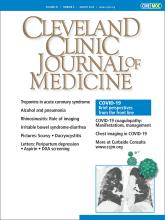A 57-year-old woman presented with swelling, pain, and redness over the left eye for the past 2 days. She reported no history of trauma or fever. Examination revealed a diffuse, tender, warm swelling over the left medial canthus with purulent discharge at the inferior punctum, conjunctival injection, and swelling of the eyelids (Figure 1). A diagnosis of acute dacryocystitis with preseptal cellulitis was made, and she was started on intravenous amoxicillin-clavulanic acid, analgesics, and topical heat application. Endoscopic intranasal drainage of the sac was performed. She recovered completely and was asymptomatic at follow-up 2 months later.
Diffuse swelling of the left medial canthus and eyelids.
ACUTE DACRYOCYSTITIS
Acute dacryocystitis is inflammation of the lacrimal sac. Common implicated causative organisms are Staphylococcus species, beta-hemolytic streptococci, pneumococci, and Haemophilus influenzae.1 Its pathogenesis is related to blockage of the nasolacrimal duct, which is either primary or secondary to trauma, infection, neoplasm, or an intranasal pathology such as deviated nasal septum or rhinitis.1 The obstruction results in stasis of secretions in the sac, leading to infection.
Patients present with the sudden onset of redness, swelling, and pain in the medial part of the orbit. Extension of the swelling around the eye and conjunctival injection implies the development of preseptal cellulitis.2 Complications, more commonly occurring in children, include eyelid necrosis, orbital cellulitis, orbital abscess, and vision loss.2 Proptosis, pain with moving the eye, and ophthalmoplegia suggest orbital cellulitis.
The differential diagnosis includes acute ethmoid sinusitis, lacrimal sac or sinonasal tumor, and infected sebaceous cyst. Diagnosis is aided by contrast-enhanced computed tomography, which helps define the extent of infection, differentiates between preseptal and orbital cellulitis, and detects associated pathology in the sinuses and surrounding structures. However, imaging was not necessary in this patient because her clinical symptoms and signs confirmed the diagnosis.
Treatment includes antibiotics (eg, amoxicillin, ciprofloxacin, clindamycin) and drainage of the abscess. The route of administration of antibiotic depends on the severity of the infection, with an intravenous route preferred in the presence of complications.
Traditionally, dacryocystorhinostomy is delayed until after the acute phase is over. But studies have shown that early endoscopic dacryocystorhinostomy is safe and reduces the duration of cellulitis.3
- Copyright © 2020 The Cleveland Clinic Foundation. All Rights Reserved.







